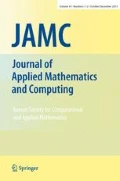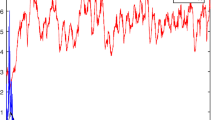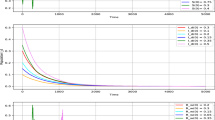Abstract
This paper is concerned with the dynamical behaviors of a model of syphilis transmission disturbed by both white noises and telegraph noises. Multiple infections and treatment stages are considered, which include and extend the existing ones. The existence and ergodicity of the stationary distribution are obtained by constructing a suitable Lyapunov function, which determines a critical value \(R_0^*\) corresponding to the control reproduction number \(R_c\) of the corresponding determined system. In addition, a sufficient criteria for extinction of the diseases is derived. Finally, the numerical simulations illustrate our theoretical results, which show that, the stronger white noises can result in the extinction of the diseases and telegraph noises can strength the stability of the system.





Similar content being viewed by others
References
Pakar, I., Bayat, M., Bayat, M.: On the approximate analytical solution for parametrically excited nonlinear oscillators. J. VibroEng. 14, 423–429 (2012)
Bayat, M., Pakar, I.: Nonlinear free vibration analysis of tapered beams by Hamiltonian approach. J. VibroEng. 13, 654–661 (2011)
Pakar, I., Bayat, M.: Analytical study on the non-linear vibration of Euler–Bernoulli beams. J. VibroEng. 14, 216–224 (2012)
Zuo, W., Jiang, D.: Periodic solutions for a stochastic non-autonomous Holling–Tanner predator–prey system with impulses. Nonlinear Anal. Hybrid Syst. 22, 191–201 (2016)
Sun, X., Zuo, W., Jiang, D., Hayat, T.: Unique stationary distribution and ergodicity of a stochastic Logistic model with distributed delay. Phys. A 512, 864–881 (2018)
Ji, C., Jiang, D., Shi, N.: Analysis of a predator–prey model with modified Leslie–Gower and Holling-type II schemes with stochastic perturbation. J. Math. Anal. Appl. 359(2), 482–498 (2009)
Song, M., Zuo, W., Jiang, D., Hayat, T.: Stationary distribution and ergodicity of a stochastic cholera model with multiple pathways of transmission. J. Frankl. Inst. (2020). https://doi.org/10.1016/j.jfranklin.2020.04.061
Song, Y., Jiang, H., Yuan, Y.: Turing-Hopf bifurcation in the reaction-diffusion in the reaction-diffusion system with delay and application to a diffusive predator–prey model. J. Appl. Anal. Comput. 9, 1132–1164 (2019)
Zuo, W., Song, Y.: Stability and Double-Hopf bifurcations of a Gause-Kolmogorov-type predator-prey system with indirect prey-taxis. J. Dyn. Differ. Equ. (2020). https://doi.org/10.1007/s10884-020-09878-9
LaFond, R., Lukehart, S.: Biological basis for syphilis. Clin. Microbiol. Rev. 19(1), 29–49 (2006)
Garnett, G.P., Aral, S.O., Hoyle, D.V., Cates, W., Anderson, R.M.: The natural history of syphilis: implications for the transmission dynamics and control of infection. Sex. Transm. Dis. 24, 185–200 (1997)
Louis, M.E.S., Wasserheit, J.N.: Elimination of syphilis in the United States. Science 281, 353–354 (1998)
Leichliter, J.S., Grey, J.A., Cuffe, K.M., et al.: Geographic correlates of primary and secondary syphilis among men who have sex with men in the United States. Ann. Epidemiol. 32, 12–19 (2019)
Read, P., Fairley, C.K., Chow, E.P.F.: Increasing trends of syphilis among men who have sex with men in high income countries. Sex. Health 12, 155–163 (2015)
Heffelfinger, J.D., Swint, E.B., Berman, S.M., Weinstock, H.S.: Trends in primary and secondary syphilis among men who have sex with men in the United States. Am. J. Public Health 97, 1076–1083 (2007)
Singh, A.E., Romanowski, B.: Syphilis: review with emphasis on clinical, epidemiologic, and some biologic features. Clin. Microbiol. Rev. 203, 187–209 (1999)
Workowski, K.A., Bolan, G.A.: Sexually transmitted diseases treatment guidelines. MMWR Morbid. Mortal. Wkly. Rep. 64, 1–137 (2015)
Saad-Roy, C.M., Shuai, Z., Driessche, P.: A mathematical model of syphilis transmission in an MSM population. Math. Biosci. 277, 59–70 (2016)
Iboi, E., Okuonghae, D.: Population dynamics of a mathematical model for syphilis. Appl. Math. Model. 40(5–6), 3573–3590 (2016)
Tuite, A.R., Fisman, D.N., Mishra, S.: Screen more or screen more often? Using mathematical models to inform syphilis control strategies. BMC Public Health 13, 1–9 (2013)
Pourbohloul, B., Rekart, M., Brunham, R.: Impact of mass treatment on syphilis transmission—a mathematical modeling approach. Sex. Transm. Dis. 30(4), 297–305 (2003)
Milner, F.A., Zhao, R.: A new mathematical model of syphilis. Math. Model. Nat. Phenom. 5(6), 96–108 (2010)
Fenton, K.A., Breban, R., Vardavas, R., Okano, J.T., Martin, T., Aral, S., Blower, S.: Infectious syphilis in high-income settings in the 21st century. Lancet Infect. Dis. 8(4), 244–253 (2008)
Li, D., Chen, Z., Tao, C.: Comparison of three syphilis algorithms in West China. Clin. Chim. Acta 488, 76–80 (2019)
Yang, Q., Jiang, D., Shi, N., Ji, C.: The ergodicity and extinction of stochastically perturbed SIR and SEIR epidemic models with saturated incidence. J. Math. Anal. Appl. 388(1), 248–271 (2012)
Lin, Y., Jiang, D.: Threshold behavior in a stochastic SIS epidemic model with standard incidence. J. Dyn. Differ. Equ. 26(4), 1079–1094 (2014)
Liu, M., Bai, C.: Optimal harvesting policy of a stochastic food chain population model. Appl. Math. Comput. 245, 265–270 (2014)
Luo, Q., Mao, X.: Stochastic population dynamics under regime switching II. J. Math. Anal. Appl. 355(2), 577–593 (2009)
Zhu, C., Yin, G.: Asymptotic properties of hybrid diffusion systems. SIAM J. Control Optim. 46(4), 1155–1179 (2007)
Liu, Q.: The threshold of a stochastic susceptible-Infective epidemic model under regime switching. Nonlinear Anal. Hybrid Syst. 21, 49–58 (2016)
Qi, K., Jiang, D.: Threshold behavior in a stochastic HTLV-I infection model with CTL immune response and regime switching. Math. Methods Appl. Sci. 41(16), 6866–6882 (2018)
Liu, Q., Jiang, D., Shi, N.: Threshold behavior in a stochastic SIQR epidemic model with standard incidence and regime switching. Appl. Math. Comput. 316, 310–325 (2018)
Zuo, W., Jiang, D.: Stationary distribution and periodic solution for stochastic predator–prey systems with nonlinear predator harvesting. Commun. Nonlinear Sci. Numer. Simul. 36, 65–80 (2016)
Du, N.H., Kon, R., Sato, K., Takeuchi, Y.: Dynamical behavior of Lotka–Volterra competition systems: non-autonomous bistable case and the effect of telegraph noise. J. Comput. Appl. Math. 170(2), 399–422 (2004)
Settati, A., Lahrouz, A.: Stationary distribution of stochastic population systems under regime switching. Appl. Math. Comput. 244, 235–243 (2014)
Zhu, Q.: pth Moment exponential stability of impulsive stochastic functional differential equations with Markovian switching. J. Frankl. Inst. 351(7), 3965–3986 (2014)
Wang, B., Zhu, Q.: Stability analysis of semi-Markov switched stochastic systems. Automatica 94, 72–80 (2018)
Wang, B., Zhu, Q.: Stability analysis of discrete-time semi-Markov jump linear systems. IEEE Trans. Autom. Control (2020). https://doi.org/10.1109/TAC.2020.2977939
Lee, T.H., Park, J.H., Xu, S.: Relaxed conditions for stability of time-varying delay systems. Automatica 75, 11–15 (2017)
Zhang, R., Zeng, D., Zhong, S.: Novel master-slave synchronization criteria of chaotic Lur’e systems with time delays using sampled-data. J. Frankl. Inst. 354(12), 4930–4954 (2017)
Khasminskii, R.: Stochastic Stability of Differential Equations. Alphen aan den Rijn-Germantown (1980)
Zu, L., Jiang, D., O’Regan, D., Hayat, T., Ahmad, B.: Ergodic property of a Lotka-Volterra predator-prey model with white noise higher order perturbation under regime switching. Appl. Math. Comput. 330, 93–102 (2018)
Liu, Q., Jiang, D., Hayat, T., Ahmad, A.: Dynamical behavior of stochastic multigroup S-DI-A epidemic models for the transmission of HIV. J. Frankl. Inst. 355(13), 5830–5865 (2018)
Higham, D.: An algorithmic introduction to numerical simulation of stochastic differential equations. SIAM Rev. 43(3), 525–546 (2001)
Zhu, Q.: Stability analysis of stochastic delay differential equations with Levy noise. Syst. Control Lett. 118, 62–68 (2018)
Acknowledgements
The work is supported by the NSFC of China (Nos. 11671236, 11871473) and Shandong Provincial Natural Science Foundation (Nos. ZR2019MA006, ZR2019MA010), and the Fundamental Research Funds for the Central Universities (No. 19CX02055A).
Author information
Authors and Affiliations
Corresponding author
Additional information
Publisher's Note
Springer Nature remains neutral with regard to jurisdictional claims in published maps and institutional affiliations.
Rights and permissions
About this article
Cite this article
Zhou, Y., Zuo, W., Jiang, D. et al. Stationary distribution and extinction of a stochastic model of syphilis transmission in an MSM population with telegraph noises. J. Appl. Math. Comput. 66, 645–672 (2021). https://doi.org/10.1007/s12190-020-01453-1
Received:
Revised:
Accepted:
Published:
Issue Date:
DOI: https://doi.org/10.1007/s12190-020-01453-1




